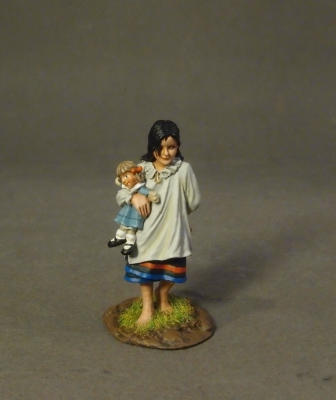
RSF-33
“LITTLE JULIE”2017
(1pc)
US$39
In the British Army, motorcycle despatch riders
were first used in the World War I by the Royal Engineers Signal Service.
When the War Department called for motorcyclists to volunteer
with their machines for despatch work at the start of August 1914,
the response was huge.
The London office had 2000 more applicants than places,
and a similar response was reported in regional centres around the country.
If a rider and machine were approved then £10 was paid immediately,
£5 to be paid on discharge (unless due to misconduct),
and pay was 35s per week.
The motor cycle would be taken over at valuation price,
or would be replaced with a new one at the close of operations.
Enlistment was for one year or as long as the war might last.
The preference was for 500cc single cylinder machines
and the horizontally-opposed twin cylinder.
All machines had to have a "change speed gear".
A list of spare parts was also required to be carried.
Captive-taking by Native Americans was surprisingly common in Colonial times.
It was also common for captives to choose their Native communities
over their Colonial families.
This puzzled the European Americans.
They came to America believing that conversion would be easy once Natives saw the superiority of the Europeans’
religion, clothing, agriculture, dwellings,
and every comfort known so far to man.
Yet there were very few Indians who converted to English culture,
while large numbers of English chose to become Indian.
Even Benjamin Franklin pondered,
“When an Indian child has been brought up among us,
taught our language and habituated to our customs,
yet if he goes to see his relations and makes one Indian ramble with them,
there is no persuading him ever to return.
[But]
when white persons of either sex have been taken prisoners young by the Indians,
and lived a while among them,
tho’ ransomed by their friends,
and treated with all imaginable tenderness
to prevail with them to stay among the English,
yet in a short time they become disgusted with our manner of life,
and the care and pains that are necessary to support it,
and take the first good opportunity of escaping again into the woods,
from whence there is no reclaiming them.”
Amongst the many who were captured was Mary Jemison.
Mary Jemison was born on the ship that brought her Irish parents,
brothers and sisters to America in 1743.
A few years later her family moved from Philadelphia
to a homestead on the Pennsylvania frontier.
The family toiled on the edge of civilization
transforming the wilderness to cultivated soil.
Each new day brought with it the fear of attack by wild beast or hostile indian.
Those fears became a reality on the morning of a spring day in 1758.
The British colonies were engulfed in a war against the French.
On that spring morning in 1758 a small raiding party
made up of French and Indians swooped down
on the frontier settlement capturing a number of British colonists
including Mary Jemison and most of her family.
From that day until her death 78 years later,
she was never to leave the Indian culture.
Her story of her capture and life amongst the Seneca was first published in 1824.
We now accept PAYPAL,
to purchase your figures please send your order by e-mail to
inquiry@johnjenkinsdesigns.com
after checking that everything is available,
you will be billed via PAYPAL.
your order will be shipped on confirmation of payment.
worldwide airmail 12%
(minimum postage us$10)
JOHN JENKINS DESIGNS
UNIT 6E, TOWER 2,
KING LEY INDUSTRIAL BUILDING,
33-35 YIP KAN STREET,
WONG CHUK HANG,
HONG KONG
Tel: 852 9041 9065
